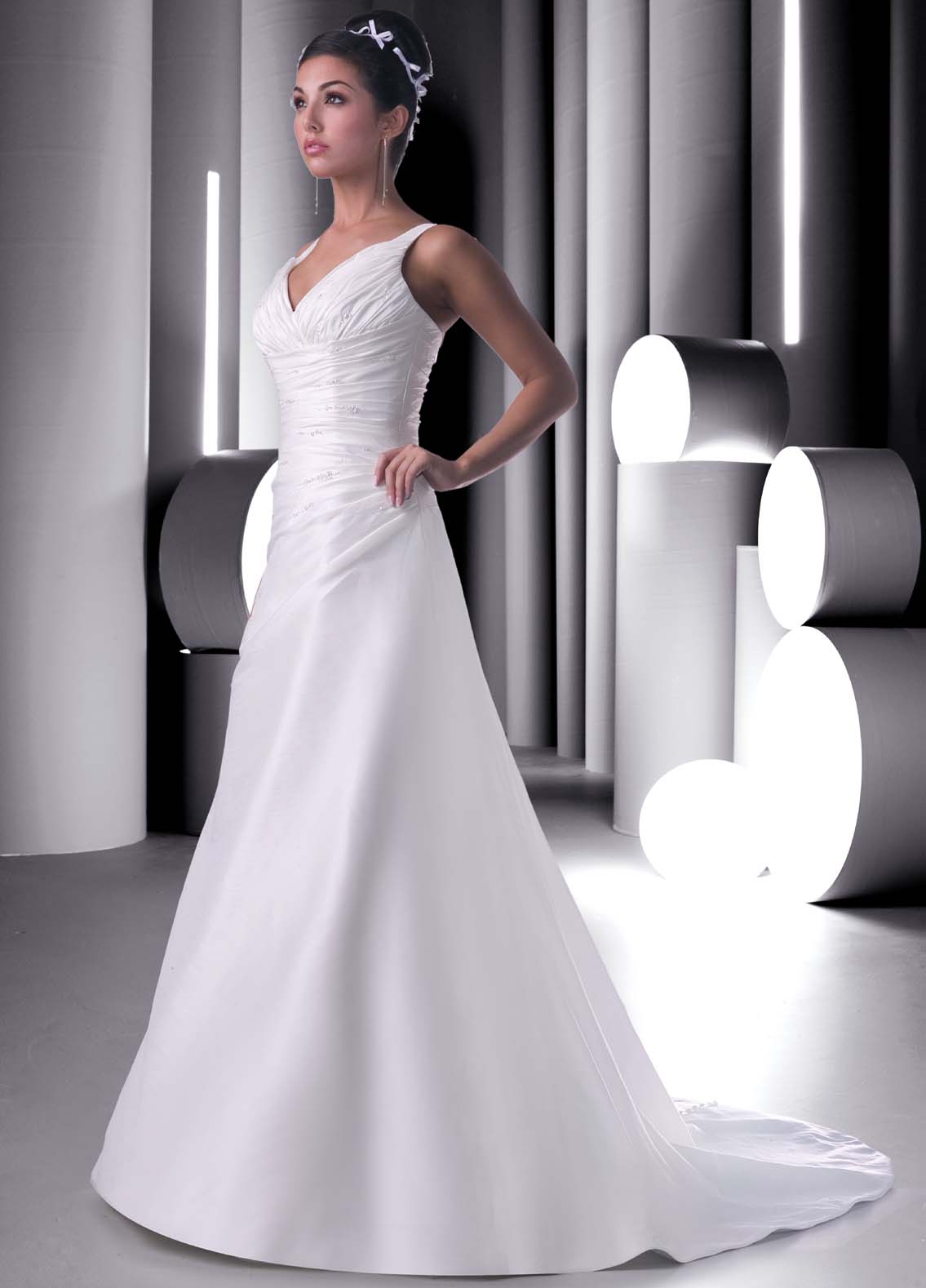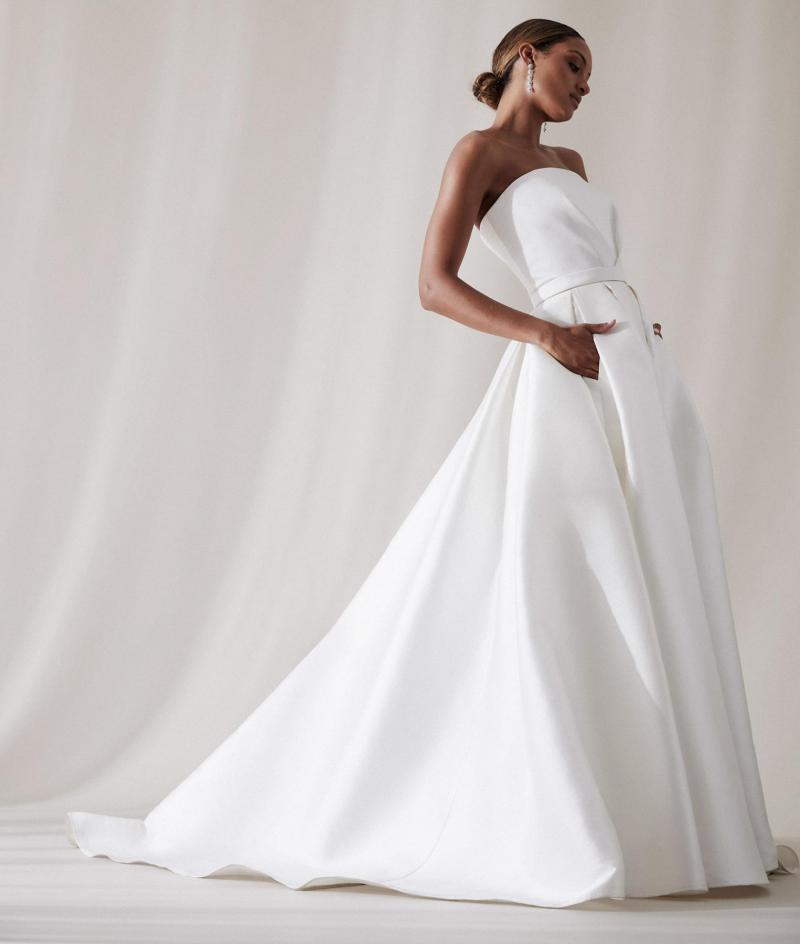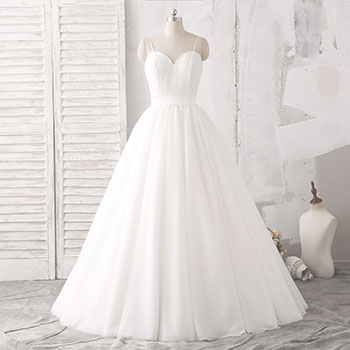Silhouette:

- A-Line: A graceful and universally flattering silhouette that widens gradually from the shoulders to the hem.
- Ball Gown: A classic and glamorous silhouette with a fitted bodice and a full, voluminous skirt.
- Sheath: A sleek and sophisticated silhouette that follows the body’s natural curves.
- Trumpet/Mermaid: A body-hugging silhouette that flares out elegantly at the knees or below.
Neckline:

- Sweetheart: A flattering neckline that resembles the shape of a heart.
- V-Neck: A plunging neckline that elongates the neck and creates a slimming effect.
- Off-the-Shoulder: A romantic and bohemian neckline that exposes the shoulders and collarbone.
- Halter: A neckline that connects at the nape of the neck and creates a supported and elegant look.
Sleeves:

- Sleeveless: A classic and airy option that allows for maximum arm movement.
- Cap Sleeves: Short, puffed sleeves that cover the tops of the shoulders.
- Long Sleeves: Sleeves that extend to the wrists, providing coverage and warmth.
- Lace Sleeves: Sleeves made with delicate lace for a feminine and ethereal touch.
Fabric:
- Lace: A luxurious and romantic fabric that creates intricate and beautiful patterns.
- Tulle: A soft and lightweight fabric that adds volume and movement to the dress.
- Satin: A lustrous and elegant fabric that provides a smooth and polished finish.
- Chiffon: A sheer and airy fabric that creates a flowing and ethereal silhouette.
Embellishments:
- Beading: Intricate beading can add sparkle and glamour to the dress.
- Lace Appliqués: Delicate lace appliqués can create a romantic and vintage-inspired look.
- Embroidery: Embroidered patterns can add intricate details and depth to the dress.
- Bow: A classic and elegant embellishment that can add a touch of sweetness or drama.
Train:
- Chapel Length: A medium-length train that extends to the floor.
- Cathedral Length: A dramatic and majestic train that extends several feet behind the dress.
- No Train: A trainless dress provides a clean and modern look.
- Watteau Train: A detached train that attaches at the shoulders or waist, adding a touch of whimsy.
Accessories:
- Veil: A traditional accessory that can add elegance and mystery to the look.
- Jewelry: Delicate jewelry, such as earrings, necklace, and bracelet, can complement the dress.
- Gloves: Gloves can add a touch of sophistication and warmth to the ensemble.
- Headpiece: A headpiece, such as a tiara, headband, or flower crown, can add a unique and personal touch.## Design Your Own Wedding Dress
Executive Summary
Designing your own wedding dress is a unique and rewarding experience. With careful planning and attention to detail, you can create a one-of-a-kind gown that perfectly reflects your personal style and vision for your special day. This comprehensive guide will provide you with all the essential information you need to embark on this exciting journey, from choosing the right fabric and design elements to finding the perfect seamstress and ensuring a flawless fit.
Introduction
Your wedding dress is a cherished symbol of your love and commitment, a timeless reminder of one of the most important days of your life. With so much significance attached to this special garment, it’s only natural to desire a dress that is truly unique and personal to you. Designing your own wedding dress allows you to express your individuality and create a gown that is tailored to your exact specifications.
FAQs
1. How do I start designing my own wedding dress?
The first step is to gather inspiration. Look through bridal magazines, visit wedding dress boutiques, and browse online galleries to get ideas for the silhouette, neckline, and embellishments you like. Once you have a general idea of the style you want, you can begin sketching out your design.
2. What fabrics are best for wedding dresses?
The choice of fabric will depend on the style and formality of your dress. Common choices include silk, lace, taffeta, chiffon, and organza. Silk is a luxurious and elegant fabric that drapes beautifully. Lace adds a touch of romance and femininity. Taffeta is a crisp and structured fabric that holds its shape well. Chiffon is a sheer and airy fabric that creates a floaty and ethereal effect. Organza is a lightweight and sheer fabric that can be used to create overlays or ruffles.
3. How do I find the right seamstress?
Finding a skilled and experienced seamstress is crucial to ensuring that your dress is made to perfection. Ask for recommendations from friends or family members who have had wedding dresses made. You can also search online for seamstresses in your area. Once you have found a few potential seamstresses, schedule consultations to discuss your design ideas and get an estimate for their services.
Top 5 Subtopics
1. Choosing the Right Silhouette
The silhouette of your dress will set the overall tone for your look. Here are four popular silhouettes to consider:
- A-line: A flattering silhouette for most body types, featuring a fitted bodice that flares out gradually from the waist.
- Ball gown: A classic and romantic silhouette, characterized by a full and voluminous skirt.
- Mermaid: A figure-hugging silhouette that flares out at the knees, creating a dramatic and alluring effect.
- Sheath: A sleek and sophisticated silhouette that follows the contours of the body, creating a modern and minimalist look.
2. Designing the Neckline
The neckline of your dress can highlight your best features and create a desired effect. Here are a few neckline options to consider:
- Sweetheart: A flattering neckline that creates a gentle curve over the bust.
- V-neck: A versatile neckline that can elongate the neck and create a slimming effect.
- Halter: A neckline that ties behind the neck, creating a sophisticated and modern look.
- Off-the-shoulder: A romantic and ethereal neckline that exposes the shoulders.
3. Adding Embellishments
Embellishments can add a touch of sparkle and glamour to your dress. Here are a few popular embellishment options:
- Beading: Intricate beading can create a luxurious and elegant effect.
- Lace: Delicate lace can add a touch of romance and femininity.
- Sequins: Shimmering sequins can add a touch of sparkle and glamour.
- Crystals: Faceted crystals can create a dramatic and eye-catching effect.
4. Selecting the Accessories
The right accessories can complement your dress and create a polished look. Here are a few essential accessories to consider:
- Veil: A veil can add a touch of drama and romance to your look.
- Headpiece: A headpiece can add a touch of sparkle and glamour to your hair.
- Jewelry: Jewelry can add a personal touch to your ensemble.
- Shoes: The right shoes will complete your look and ensure that you’re comfortable on your big day.
5. Ensuring a Perfect Fit
A perfect fit is essential for creating a flattering and comfortable dress. Here are a few tips for ensuring a perfect fit:
- Attend multiple fittings: Regular fittings throughout the construction process will allow the seamstress to make adjustments and ensure that the dress fits perfectly.
- Bring your undergarments to fittings: Wearing the undergarments you plan to wear on your wedding day will help the seamstress ensure that the dress fits properly over them.
- Don’t be afraid to ask for alterations: If there are any areas where the dress doesn’t fit perfectly, don’t be afraid to ask the seamstress to make alterations.
Conclusion
Designing your own wedding dress is a truly special experience that allows you to create a one-of-a-kind gown that perfectly reflects your personal style and vision for your wedding day. By following the tips and suggestions outlined in this guide, you can embark on this exciting journey with confidence and create a dress that you will cherish for a lifetime.
Keyword Tags
- wedding dress design
- custom wedding dress
- design your own wedding dress
- wedding dress silhouette
- wedding dress embellishments







